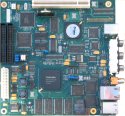Linux stack supports mini-ITX PVR/VOD/IPSTB reference design
Aug 12, 2005 — by LinuxDevices Staff — from the LinuxDevices Archive — 4 views Oregan Networks is shipping a Linux multimedia software stack for a mini-ITX-based hardware reference design from Toshiba. The stack provides IPTV, VOD (video on demand), and PVR (personal video recorder) functions, runs on MontaVista Linux, and targets “convergent vertical market media devices,” the… company says.
Oregan Networks is shipping a Linux multimedia software stack for a mini-ITX-based hardware reference design from Toshiba. The stack provides IPTV, VOD (video on demand), and PVR (personal video recorder) functions, runs on MontaVista Linux, and targets “convergent vertical market media devices,” the… company says.
(Click for larger view of Toshiba's AVM49R reference design)
The Oregan Networks multimedia stack runs on top of Toshiba's AVM49R reference design, which is based on a mini-ITX board powered by a 333MHz MIPS processor, along with a dedicated codec chip. The Toshiba design also includes a Linux operating system based on MontaVista Linux Professional Edition 3.1, a kernel patch, a design specification, component data sheets, schematics, gerber database, CPLD/FPGA source code, and documentation. Another Linux-based application stack for the same Toshiba board was shipped in January by TVBLOB.
Oregan Networks says its multimedia application stack is suitable for integration with content services, thanks to an extensive API ready for Conditional Access and DRM technologies. The stack includes modular building blocks to deliver various kinds of media. It also includes tools that can be used to customize or re-design the user interface, the company says, which can be based on HTML 4.01, DHTML, or Flash.
Tetsuro Wada, director of technical marketing at Toshiba America Electronic Components (TAEC), said, “Oregan Media Browser [enables] delivery of source-independent video, audio, and gaming functions. The platform is optimal for enabling fast and cost-effective deployment of highly reliable unicast and multicast-based services.”
Oregan's VP of business development, Reed Hinkel, said, “(TAEC's) AVM49R is a powerful, yet cost-effective reference design, supporting a complete set of vital hardware, middleware, and application components. Oregan's ANSI C-based suite of UI rendering and IP media delivery building blocks vastly outperforms Java solutions in terms of speed and footprint.”
This article was originally published on LinuxDevices.com and has been donated to the open source community by QuinStreet Inc. Please visit LinuxToday.com for up-to-date news and articles about Linux and open source.